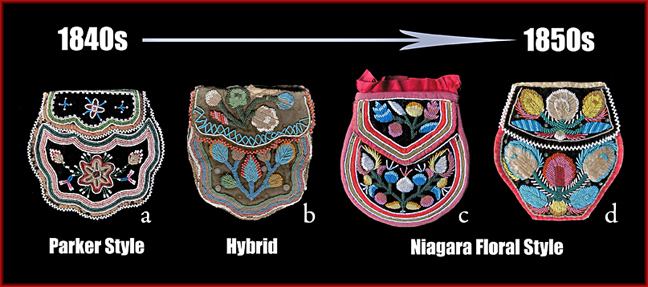The Niagara floral style possibly evolved from the Tonawanda Seneca style described on a previous page. The bag in example (a) for instance, is done in this Tonawanda Seneca style. The flap and lower edges of the bag are scalloped and there are several strings of beads in a wide band that run along the perimeter of the bag face which is typical of bags in this style.
Several collections include examples of a hybridized bag (example b – from the collection of Naomi Smith) that appears to have evolved from the Tonawanda style. These hybrid bags are typically from the early to mid 1840s and they retain characteristics of the Tonawanda style, such as a scalloped edge and a wide band of beads along the perimeter, yet they also incorporate elements of the emerging Niagara floral style, such as ovate flowers with long, thick stems. It suggests that Native beadworkers were innovative and experimenting with the form, especially with the internal floral designs. Some of the flowering observed on hybrid bags is also very similar to that seen on some of the Tonawanda style examples. Occasionally found is a hybrid bag with a silk edge binding. From time to time, fabric inlays, celestial dome motifs, even the use of the double-curve is observed on a hybrid bag. Many of these bags are scalloped and the heavy band of beads along the perimeter and the characteristic floral motifs from the Niagara floral style are invariably present.
The bag in example (c), though lacking the strings of beads that form the wide band, instead uses fabric inlays, each bordered by a single bead string to form this marginal band.
The bag in example (d), with a bilaterally symmetrical design, is now lacking any vestige of the borderline band and the Niagara floral style, with ovate flowers and long stems, is fully developed.
In the Niagara floral style, several beading techniques were used along the perimeter of the bag. Some had short strings of beads in a lane stitch, attached perpendicularly to a single string that ran along the edge of the bag. Other variations can also be found and these techniques may have been a variant method or perhaps an expeditious treatment of the wide band of beads that appears along the perimeter of the Tonawanda style bags.
The probable evolution of these bags from the Tonawanda model suggests that the style may have originated with the Seneca and possibly with Caroline Parker or someone in her immediate beading circle. Within a very short period of time, and no doubt due to its popularity, other Haudenosaunee communities started making them as museums are replete with examples that are attributed to the Seneca, Tuscarora, Mohawk, Oneida and the Onondaga.
From a study of ethnology we learn that where peoples live in contact, their established or traditional way of doing things can change. They learn from one another and they take on each other’s customs, ceremonies and art practices. Nor is it uncommon in a small community for a new idea to take off quickly and there is a precedent for this among the Northeast Woodland tribes. Ernest Dodge, the former director of the Peabody Museum, wrote that:
Another motivating and energizing force is the example of the great artist. All people are not equally skilled in art work and this applies to Indians as well as whites. Occasionally there arose such a person as Tomah Joseph, the great chief of the Passamaquoddy… He was not educated beyond his brethren but he was a man of great simple wisdom, and he was an artist. He was particularly adept at bark engraving. He must have made hundreds if not thousands of bark boxes… He was an exceptional man… [and] the point for us, however, is that he established a style which has been copied by many other Quoddy bark workers ever since, and his influence has even penetrated among the Malecite groups up the St. John River and to Old Town (Dodge 1951:2).
As a general rule, bags from the early Niagara floral style (late-1830s to mid-1850s) had long beaded stems, usually in dark transparent green, though blue is occasionally used and there are other exceptions. The flowers were typically ovate and the earliest bags in this style often had smaller beads than later examples. All of the primary and most of the secondary colors were used to delineate the flowers. Red, white, pink, rose, pumpkin, crystal, opaque yellow, greasy and transparent yellow, and various shades of blue were the predominant bead colors used. Occasionally purple, violet and green are seen in the flowers and other combinations are sometimes found. The ovate flowers were often done in two shades of the same hue: typically a medium blue surrounding a pale blue, wine red surrounding pink, solid yellow surrounding transparent yellow, or white surrounding crystal. There were a fair number of exceptions to this, and on occasion the flowers were depicted in three and four colors. Generally, Native beadworkers opted for the two-color combinations. Occasionally, green beads were used for flowers but generally green was reserved for stems and occasionally it was used for the leaves. Numerous examples from the early period had bilaterally symmetrical designs.
Vast quantities of these were made and sold after 1845 and in all likelihood, a commercial motive influenced the rapid dispersion of the style to other Haudenosaunee communities. These bags were pervasive and the extent to which they were admired by Victorian women no doubt fueled the dissemination of the style throughout the region.
Dodge, Ernest S. 1951 Some Thoughts on the Historic Art of the Indians of Northeastern North American, in the Massachusetts Archaeological Society Bulletin, 13, vol. 1
